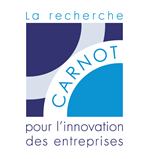Carnot institutes & enterprises - nov13
-
Fullbody Exoskeleton at SIGGRAPH 2013 : Developed entirely in the Ile-de-France region by Carnot institute CEA LIST, EMY (Enhancing MobilitY) is a full-body exoskeleton designed to help quadriplegic people regain mobility.
- In July, Alchimer signs Collaboration with CEA-Leti to Evaluate Metallization Processes for High Aspect Ratio TSV Applications.
<h3> Fullbody Exoskeleton at SIGGRAPH 2013</h3> <p> Developed entirely in the Ile-de-France region by Carnot institute CEA LIST, EMY (Enhancing MobilitY) is a full-body exoskeleton designed to help quadriplegic people regain mobility.</p> <p> Packed full with innovative technology, EMY is the fruit of 10 years of research by CEA LIST's interactive robotics unit and draws on extensive expertise in force control actuation, as well as the associated innovative robotic architectures.</p> <p> EMY's architecture features four limbs: two legs with three degrees of freedom each, and two ABLE anthropomorphic arms with seven degrees of freedom each. To enable control by a quadriplegic patient, the exoskeleton will ultimately be controlled via a brain-computer interface - or BCI - called WIMAGINE®, developed by Carnot institute CEA LETI at Clinatec. The interface between the BCI and the exoskeleton will be ensured by a physics-simulation engine called XDE, also developed by Carnot institute CEA LIST. XDE is a haptic tool that simulates movement, contact and friction between virtual objects. This simulation layer allows EMY to be controlled at different levels of complexity, from the control of simple joint movements to abstract tasks coordinating the use of several limbs. As of 2014, it will also be capable of keeping the machine properly balanced.</p> <p> The exoskeleton can also be used to control virtual reality physics simulation for industrial applications associated with “digital factory” design. These applications are being rapidly developed to reduce production set-up costs.</p> <p> Thus, ABLE arms can not only control the movements of simulated objects, but also feed back the contact forces between them. Each of EMY's seven joints is equipped with a screw-cable system that exactly reproduces contact forces along the entire arm, doing away with the need for a force sensor (this function is fulfilled by the motor). Such outstanding performance is also due to the unique, lightweight, streamlined architecture which fits the human arm perfectly, without closing it in.<br /> The ABLE exoskeleton can thus perform realistic simulations of manual tasks involving contacts distributed along the entire length of the arm, for example when fitting parts inside “crowded” structures. It can also be used as an operator workstation assistant to make work less strenuous and reduce the risk of repetitive strain injuries. It does this by evenly distributing the effort when operators are holding tools and balancing part of their arm.</p> <p> <strong><em><a href="http://www-list.cea.fr/en/latest-news" target="_blank">For more information</a></em></strong></p> <h3> Alchimer Signs Collaboration with CEA-Leti to Evaluate Metallization Processes for High Aspect Ratio TSV Applications</h3> <p> <br /> Wet Nanometric Film Deposition Processes Capable of Delivering 20:1 Aspect Ratio TSVs at Low Cost of Ownership.</p> <p> Alchimer, S.A. announced a collaboration with the French research institute CEA-Leti to evaluate and implement Alchimer’s wet deposition processes for 300mm high-volume manufacturing. The project will evaluate Alchimer’s Electrografting (eG™) and Chemicalgrafting (cG™) processes for isolation, barrier and seed layers. When combined, Alchimer's wet deposition processes have been demonstrated to achieve 20:1 aspect ratio through silicon vias (TSVs) due to their ability to coat conformally regardless of via topography, diameter or depth.</p> <p> 3D integration is moving towards a “via middle” approach where TSVs are formed after front-end processes, but prior to stacking. Several applications are in the development phase, leading to constraints and different specifications for TSVs. Alchimer's technology shows the potential to break through existing barriers to achieve high aspect ratio TSVs. This collaboration will evaluate the potential of its technology and its suitability for high-volume manufacturing.</p> <p> <strong><em><a href="http://www.leti.fr/en/Latest-news/Alchimer-Signs-Collaboration-with-CEA…; target="_blank">For more information</a></em></strong></p>

